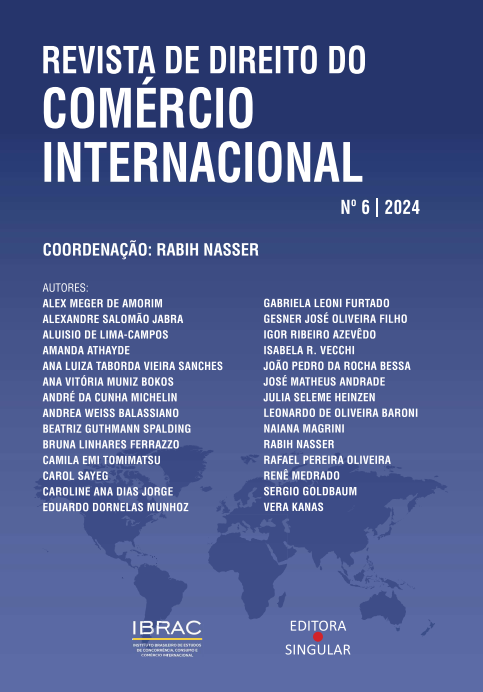Estimando alíquotas de imposto de importação dado o nível de competitividade relativa do brasil
Main Article Content
Abstract
The objective of this article is to propose a methodology based on econometric and machine learning models to estimate import
tax rates that would be expected given Brazil’s relative competitiveness level. Thus, it aims to contribute quantitatively to the debate about the appropriate degree and speed of trade openness processes, considering that there are structural and institutional bottlenecks (or ‘Custo Brasil’) that hinder the business environment and limit the competitiveness of Brazilian industries against foreign competition. The proposed methodology, which can be applied to different sectors and products of interest, uses indicators from the Global Competitiveness Index (GCI) as proxies for the competitiveness level of countries. Together with the country’s trade flows for the product of interest, these data constitute the set of covariates that explain the import tariff. This function is calibrated based on the available data between 2017 and 2019 for other countries, and then, it estimates what the tariff would be for Brazil. For
illustrative purposes, this article conducts a case study for the chemical industry, specifically for caustic soda bleach.
Article Details
References
ACEMOGLU, D.; JOHNSON, S.; ROBINSON, A. The colonial origins of comparative development: An empirical investigation. American Economic Review, v.91, n.5, p.1369-1401, 2001.
BELLOC, M.; BOWLES, S. Persistence and Change in Culture and Institutions under Autarchy, Trade, and Factor Mobility. American Economic Journal: Microeconomics, v.9, p.245-276, 2017.
BOND, E. The optimal tariff structure in higher dimensions. International Economic Review, v.31, p.103-116, 1990.
BREINLICH, H.; CORRADI, V.; ROCHA, N.; RUTA, M.; SILVA, J. M. C. S.; ZYLKIN, T. Machine learning in international trade research: Evaluating the impact of trade agreements. Policy Research Working Paper 9629, World Bank Group. 2021.
COSTINOT, A. DONALDSON, D.; VOGEL, J.; WERNING, I. Comparative advantage and optimal trade policy. The Quarterly Journal of Economics, p.659-702, 2015.
DIXIT, A. Chapter 6: Tax policy on open economies in Handbook of Public Economics vol.1. Elservier Science Publishers B.V., 1985.
DUDEK, G. A Comprehensive Study of Random Forest for Short-Term Load Forecasting. Energies, v. 15, n. 20, p. 7547, 2022.
FAN, H.; LI, Y.; YEAPLE, S. Trade liberalization, quality and export prices. Review of Economics and Statistics, v.97, n.5, 2015.
FRIEDMAN, J; HASTIE, T; TIBSHIRANI, R. Regularization paths for generalized linear models via coordinate descent. Journal of statistical software, v. 33, n. 1, p. 1, 2010.
FURCERI, D; HANNAN, S; OSTRY, J; ROSE, A. Are tariffs bad for growth? Yes, say five decades of data from 150 countries. Journal of Policy Modeling, v.42, p.850-859, 2020.
HAMNER, B; FRASCO, M. Metrics: Evaluation Metrics for Machine Learning. R Package. 2018. Disponível em: https://CRAN.R-project.org/package=Metrics. Acesso em: 30/07/2023.
HAYAKAWA, K.; ISHIKAWA, J.; TARUI, N. What goes around comes around: Export-enhancing effects of import-tariff reductions. Journal of International Economics, v.126, 2020.
IDICULA-THOMAS, S.; GAWDE, U.; JHA, P. Comparison of machine learning algorithms applied to symptoms to determine infectious causes of death in children: national survey of 18,000 verbal autopsies in the Million Death Study in India. BMC Public Health, out. 2021. DOI: 10.1186/s12889-021-11829-y.
JANSEN, M.; NORDAS, H. K. Institution, trade policy and trade flows. Staff Working Paper ERSD-2004-02, World Trade Organization, Economic Research and Statistics Division, 2004.
KIM, I. S. Political cleavages within industry: Firm-level lobbying for trade liberalization. American Political Science Review, v. 111, n. 1, p. 1-20, 2017.
KUHN, M. Building Predictive Models in R Using the caret Package. Journal of Statistical Software, v.28, n.5, pág.1-26, 2008.
MAMOON, D.; MURSHED, S. M. Trade policy, openness, institutions. The Pakistan Development Review, v.45, n.1, p.99-119, 2006.
NAIDIN, L. C.; VEIGA, P. da M.; RIOS, S. P. Liberalização comercial sob Bolsonaro: O que foi feito e o que pode ser feito até o final do governo. Centro de Estudos de Integração e Desenvolvimento (CINDES). 2021.
NUNN, N.; TREFLER, D. The structure of tariffs and long-term growth. American Economic Journal: Macroeconomics, v.2, n.4, p.158-194, 2010.
PIERCE, J.; SCHOTT, P. Investment responses to trade liberalization: Evidence from U.S. industries and establishments. Journal of International Economics, v.115, p.203-222, 2018.
R Core Team. R: A language and environment for statistical computing. R Foundation for Statistical Computing. 2013. Disponível em: http://www.R-project.org/. Acesso em: 30/07/2023.
SAMUELSON, P. Ohlin was right. Swedish Journal of Economics, p.365–384, 1971.
SILVA, L. I. L.; ALCKMIN, G. Neoindustrialização para o Brasil que queremos. Governo Federal, 2023. Disponível em: https://www.gov.br/planalto/pt-br/vice-presidencia/central-de-conteudo/artigos/neoin-dustrializacao-para-o-brasil-que-queremos. Acesso em: 30/07/2023.
SHAPI, M.; RAMLI, N.; AWALIN, L. Energy consumption prediction by using machine learning for smart building: Case study in Malaysia. Developments in Built Environment, v.5, mar. 2018.
WEF. Global Competitiveness Report – 2018. World Economic Forum, 2018. Disponível em: https://www3.weforum.org/docs/GCR2018/05FullReport/TheGlobalCompetitivenessReport2018.pdf. Acesso: 30/07/2023.
